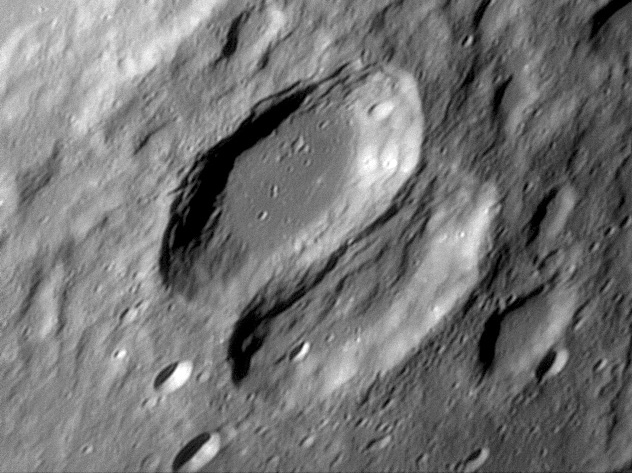image by Damian Peach
Tucked away just beyond notice on the flanks of Janssen is the crater pair of Steinheil and Watt. These two features are hardly ever commented on because they are rather plain, but like every place on the Moon there is a story of cosmic formation, instant or slow modification, and gradual decay. Steinheil (diameter 67 km) is the younger formation for it slightly overlaps Watt (66 km) – notice where the rim of Steinheil is lower and that the missing rim material has been shoved across the floor of Watt. Steinheil’s relative youthfulness is also indicated by its sharper rim, but its subdued terraces indicate that it too has been around quite awhile. Watt’s terraces are even more smoothed out – I assume the main process that transforms sharp terraces like those in Copernicus to lumpy ridges is seismic shaking from subsequent impacts. The floor of Steinheil is flat and no central peak is visible. The smooth material on the floor is not mare lava because the floor is not dark under high sun and it has no dark halo craters. The common interpretation is that such smooth fill is fluidized ejecta from some distant basin’s formation. Who knows, but the fill must have buried the central peaks. Look carefully and notice the small scarp near the northeast (upper right) edge of Steinheil’s floor. This appears to be a highwater mark caused by the subsidence of the floor fill material. By the way, Damian’s image has the same or slightly better resolution than the Lunar Orbiter IV image, and much better tonal range!
Technical Details:
Dec 20, 2005, 14″ Schmidt Cassegrain. Lumenera LU075M CCD camera..
Related Links:
Rükl chart 76
Damian’s website
Yesterday's LPOD: Plato in My Dreams
Tomorrow's LPOD: Jagged Jura
COMMENTS?
Register, and click on the Discussion tab at the top of the page.
Contributions to http://www2.lpod.org/ are licensed under a Creative Commons Attribution No-Derivative-Works Non-Commercial 3.0 License. 




